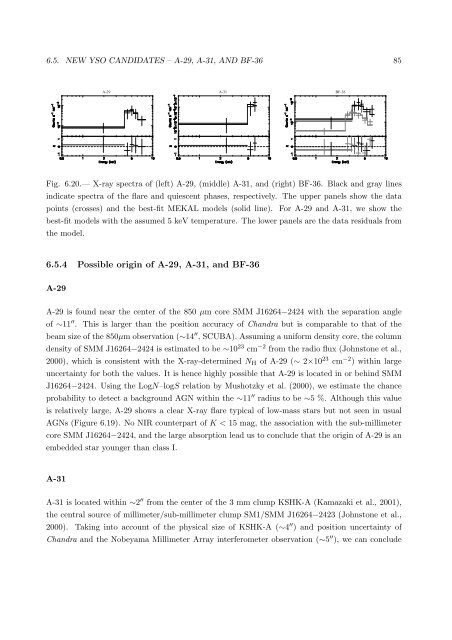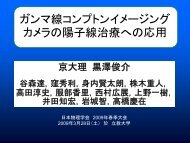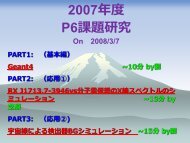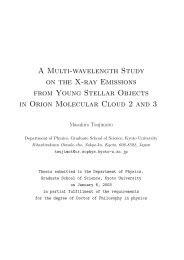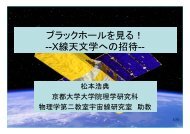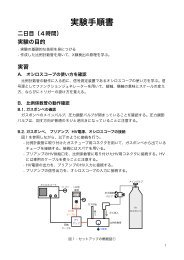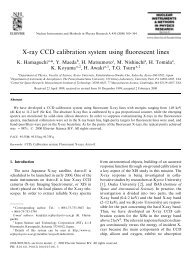X-ray Study of Low-mass Young Stellar Objects in the ρ Ophiuchi ...
X-ray Study of Low-mass Young Stellar Objects in the ρ Ophiuchi ...
X-ray Study of Low-mass Young Stellar Objects in the ρ Ophiuchi ...
You also want an ePaper? Increase the reach of your titles
YUMPU automatically turns print PDFs into web optimized ePapers that Google loves.
6.5. NEW YSO CANDIDATES – A-29, A-31, AND BF-36 85A-29 A-31 BF-36Fig. 6.20.— X-<strong>ray</strong> spectra <strong>of</strong> (left) A-29, (middle) A-31, and (right) BF-36. Black and g<strong>ray</strong> l<strong>in</strong>es<strong>in</strong>dicate spectra <strong>of</strong> <strong>the</strong> flare and quiescent phases, respectively. The upper panels show <strong>the</strong> datapo<strong>in</strong>ts (crosses) and <strong>the</strong> best-fit MEKAL models (solid l<strong>in</strong>e). For A-29 and A-31, we show <strong>the</strong>best-fit models with <strong>the</strong> assumed 5 keV temperature. The lower panels are <strong>the</strong> data residuals from<strong>the</strong> model.6.5.4 Possible orig<strong>in</strong> <strong>of</strong> A-29, A-31, and BF-36A-29A-29 is found near <strong>the</strong> center <strong>of</strong> <strong>the</strong> 850 µm core SMM J16264−2424 with <strong>the</strong> separation angle<strong>of</strong> ∼11 ′′ . This is larger than <strong>the</strong> position accuracy <strong>of</strong> Chandra but is comparable to that <strong>of</strong> <strong>the</strong>beam size <strong>of</strong> <strong>the</strong> 850µm observation (∼14 ′′ , SCUBA). Assum<strong>in</strong>g a uniform density core, <strong>the</strong> columndensity <strong>of</strong> SMM J16264−2424 is estimated to be ∼10 23 cm −2 from <strong>the</strong> radio flux (Johnstone et al.,2000), which is consistent with <strong>the</strong> X-<strong>ray</strong>-determ<strong>in</strong>ed N H <strong>of</strong> A-29 (∼ 2×10 23 cm −2 ) with<strong>in</strong> largeuncerta<strong>in</strong>ty for both <strong>the</strong> values. It is hence highly possible that A-29 is located <strong>in</strong> or beh<strong>in</strong>d SMMJ16264−2424. Us<strong>in</strong>g <strong>the</strong> LogN–logS relation by Mushotzky et al. (2000), we estimate <strong>the</strong> chanceprobability to detect a background AGN with<strong>in</strong> <strong>the</strong> ∼11 ′′ radius to be ∼5 %. Although this valueis relatively large, A-29 shows a clear X-<strong>ray</strong> flare typical <strong>of</strong> low-<strong>mass</strong> stars but not seen <strong>in</strong> usualAGNs (Figure 6.19). No NIR counterpart <strong>of</strong> K < 15 mag, <strong>the</strong> association with <strong>the</strong> sub-millimetercore SMM J16264−2424, and <strong>the</strong> large absorption lead us to conclude that <strong>the</strong> orig<strong>in</strong> <strong>of</strong> A-29 is anembedded star younger than class I.A-31A-31 is located with<strong>in</strong> ∼2 ′′ from <strong>the</strong> center <strong>of</strong> <strong>the</strong> 3 mm clump KSHK-A (Kamazaki et al., 2001),<strong>the</strong> central source <strong>of</strong> millimeter/sub-millimeter clump SM1/SMM J16264−2423 (Johnstone et al.,2000). Tak<strong>in</strong>g <strong>in</strong>to account <strong>of</strong> <strong>the</strong> physical size <strong>of</strong> KSHK-A (∼4 ′′ ) and position uncerta<strong>in</strong>ty <strong>of</strong>Chandra and <strong>the</strong> Nobeyama Millimeter Ar<strong>ray</strong> <strong>in</strong>terferometer observation (∼5 ′′ ), we can conclude


